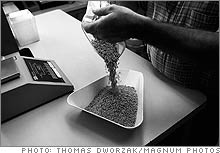Attack of the mutant riceAmerica's rice farmers didn't want to grow a genetically engineered crop. Their customers in Europe did not want to buy it. So how did it end up in our food? Fortune's Marc Gunther reports.(Fortune Magazine) -- Back in the spring of 2001, a 64-year-old Texas rice farmer named Jacko Garrett watched a fleet of 18-wheelers haul away truckloads of rice that he had grown with great care. "It just bothers me so bad," Garrett said. "I'm sitting here trying to find food to feed people, and I've got to bury five million pounds of rice." No one likes to waste food, but for Garrett, who runs a charity that collects rice for the needy, the pain was especially acute. Garrett's rice was genetically modified, part of an experiment that was brought to an abrupt halt by its sponsor, a North Carolina-based biotechnology company called Aventis Crop Science. The company had contracted with a handful of farmers to grow the rice, which was known as Liberty Link because its genes had been altered to resist a weed killer called Liberty, also made by Aventis.
But by 2001, Aventis Crop Science was living a biotech nightmare. Another one of its creations, a variety of genetically modified corn known as StarLink, had been discovered in taco shells made by Kraft. Because the StarLink corn had been approved as animal feed - and not for human consumption - all hell broke loose. Hundreds of corn products were recalled. Consumers and farmers sued. Greenpeace dumped bags of corn in front of federal regulatory agencies, and an Environmental Protection Agency official accused Aventis Crop Science of breaking the law. So shell-shocked was Aventis SA (Charts), the French pharmaceutical giant that owned Aventis Crop Science, that it decided to sell the U.S. biotech unit and abandon the very emotional business of reengineering the foods we eat. So dumping the Texas rice was a no-brainer. "We didn't want to take any chances," says a former Aventis executive. "We burned and buried enough rice to feed 20 million people." Eventually Aventis paid about $120 million to settle the StarLink lawsuits. It sold its crop science unit to Bayer (Charts), the German drug giant that makes aspirin, Aleve and Alka-Seltzer. Bayer Crop Science dropped plans to bring Liberty Link rice to market, largely because rice grown in the U.S. is exported to Europe and other places that don't want genetically modified foods. And everyone forgot about Jacko Garrett's rice. Can you guess where this is going? Yep. In January 2006, small amounts of genetically engineered rice turned up in a shipment that was tested - we don't know why - by a French customer of Riceland Foods, a big rice mill based in Stuttgart, Ark. Because no transgenic rice is grown commercially in the U.S., the people at Riceland were stunned. At first they figured that the test was a mistake or that tiny bits of genetically modified corn or soybeans had somehow gotten mixed up with rice during shipping. They said nothing. Then came another shock. Testing revealed that the genetically modified rice contained a strain of Liberty Link that had not been approved for human consumption. What's more, trace amounts of the Liberty Link had mysteriously made their way into the commercial rice supply in all five of the Southern states where long-grain rice is grown: Arkansas, Texas, Louisiana, Mississippi and Missouri. Bayer and Riceland then informed the U.S. Department of Agriculture, which announced the contamination last August. By then the tainted rice was everywhere. If in the past year or so you or your family ate Uncle Ben's, Rice Krispies, or Gerber's, or drank a Budweiser - Anheuser-Busch (Charts, Fortune 500) is America's biggest buyer of rice - you probably ingested a little bit of Liberty Link, with the unapproved gene. (A very little bit - perhaps ten to 15 grains of transgenic rice in a one-pound bag of rice, which contains about 29,000 grains.) Last November, over the howls of anti-GMO (that's genetically modified organisms) activists, the USDA retroactively approved the Liberty Link rice, known as LL601. The department said the genes that it approved are similar to those inserted for years into canola and corn, with no apparent ill effects. The experts at the USDA, the EPA and the Food and Drug Administration, all of which bear some responsibility for regulating transgenic food, say the contamination is nothing to worry about. Then again, the experts also have dismissed repeated warnings that genetically modified crops can't be managed or controlled. When organic farmers worried that their fields could be invaded by genetically modified plants grown nearby, regulators told them there was nothing to fear. The biotech industry promised that experimental, gene-altered plants could be grown in open fields and never, ever end up in the neighborhood Safeway. Oops. In any event, after last year's contamination became public, and after rice prices took a tumble, and after Europe said it no longer wanted any American rice, and after several other countries, including Japan and Iraq (!), demanded rigorous testing of U.S. rice, the industry moved to contain the damage. Rice growers were told not to plant Cheniere, a popular seed variety that had been tainted by Liberty Link genes. Regulators set up a comprehensive testing program to keep future harvests clean. Last December, Bruce Knight, a USDA official, assured worried rice farmers, "The good news is that the only foundation seed to test positive for Liberty Link was of a single variety - 2003 Cheniere." And then ... the tests that had been put in place uncovered a second contamination, and then a third, involving new, unapproved strains of Liberty Link, which turned up in another popular variety of rice seed, called Clearfield 131 (CL131). This seed variety is made by the German chemical giant BASF Corp. So the CL131 seed had to be banned as well. Yes, it's the attack of the mutant rice, and it's spreading. |
Sponsors
|

